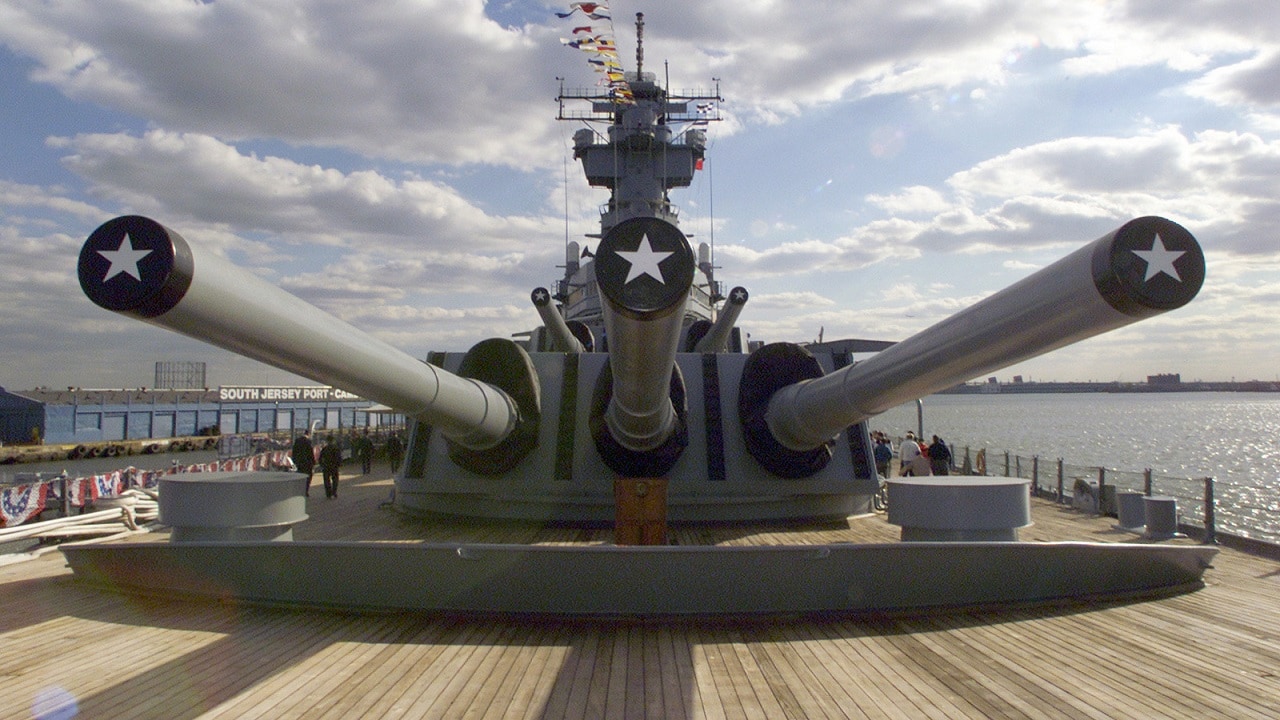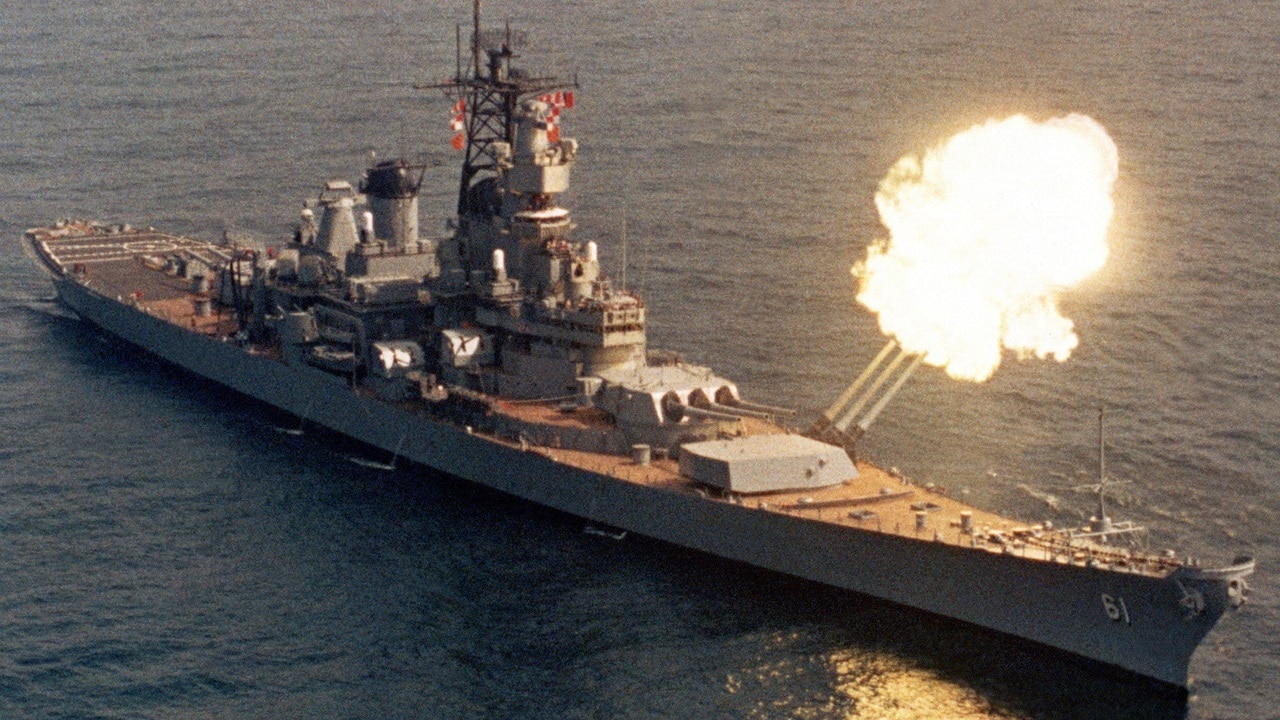Heavily Armed Battleship - The Iowa-class battleships are the most heavily armed battleships ever put to sea by the US Navy, as the weapons on board are constantly being upgraded. The first Iowa-class ship was laid down in June 1940; In World War II configuration, each of the Iowa-class battleships carried a main battery of 16-inch (406 mm) guns capable of engaging targets nearly 20 miles (32 km) away with a variety of anti-ship artillery rounds. or bombing operations. A secondary battery of 5-inch (127 mm) guns with solid shells or short-range charges could engage targets almost 14 km away and was also effective in the anti-aircraft role. Each of the four battleships carried a variety of 20mm and 40mm anti-aircraft guns for defense against enemy aircraft.
After they were reactivated and modernized in the 1980s, each battleship retained the original battery of nine 16-inch (406 mm) guns, but each battleship's secondary battery was reduced from t two gun mounts and twenty guns to six two guns. 12 gun mounts to allow installation of two platforms for Tomahawk missiles. Each battleship also received four Harpoon missile magazines, Phalanx anti-aircraft/anti-missile systems and electronic warfare suites.
Heavily Armed Battleship

USS Iowa fires nine 16-inch (406 mm)/50-caliber guns and six 5-inch (127 mm)/38-caliber guns during targeting. There is turbulence on the surface of the water, and the barrels of the 16-inch (406 mm) guns have varying degrees of recoil.
Small Warships For Ukraine To Be Built In Scotland
Which housed three 3-gun turrets: two forward and one aft in a configuration known as "2-A-1". The guns were 66 feet (20 m) long, 50 times longer than the 16-inch (410 mm) bore, or 50 caliber from breech to muzzle.
About 43 feet (13 m) protruded from the gun barrel. Each gun weighed approximately 239,000 lb (108,000 kg) without a breech or 267,900 lb (121,500 kg) with a breech.
They fired 2,700 lb (1,225 kg) armor-piercing shells at a muzzle velocity of 2,500 ft/s (762 m/s) or 1,900 lb (862 kg) high-capacity shells at 2,690 ft/s (820 m/s), up to 24 miles ( 21 miles; 39 km).
Each gun was located in an armored turret, but only the top of the turret protruded above the main deck. The turret extended either four decks (Turrets 1 and 3) or five decks (Turret 2) down. The lower rooms housed the equipment needed to rotate the turret and raise the guns attached to each turret. At the bottom of the turret were rooms used to handle the projectiles and store the powder bags used to fire them. All tower compartments were separated by fireproof bulkheads to prevent flames or deadly gases from spreading through the tower.
The Most Heavily Armoured Guided Missile Cruiser In History. Uss Mississippi (eag 128 Exbb 41) Firing A Sam N 7 Terrier Surface To Air Missile During At Sea Tests, Circa 1953 55. [5790x3801]
Although often referred to as "three-gun" turrets, they were actually classified as "three-gun" turrets due to their ability to raise and fire each gun in the turret. This is in contrast to true "three-gun" turrets, where all three guns must be operated as one.
Turrets can be rotated about 300° at a rate of about four degrees per second and can optionally be fired back behind a beam, sometimes called "over the shoulder".
The guns were never fired horizontally forward (a satellite uplink antenna was installed in the bow in the 1980s). To distinguish between rounds fired from different battleships, the Iowa class used colored pouches that allowed artillery observers to determine which ship the rounds were fired from. Iowa, New Jersey, Missouri, and Wisconsin were assigned the colors orange, blue, red, and gray, respectively.

When the guns entered service during World War II, they had a barrel life of about 290 rounds, which was largely limited by nitrate cellulose (NC) propellant.
Hms Hood: Devastating Sinking Of British Flagship By German Battleship Bismark And A Heroic Act Of Defiance Should Not Be Forgotten
After World War II, the Navy switched to smokeless powder difilamine (SPD), a cooler burning propellant that increased barrel life from 290 to about 350 rounds. This was further boosted by the introduction of a titanium dioxide-wax compound known as "Swedish additive" in New Jersey during her tour in Vietnam, and was later used in all four Iowas where they were reactivated in the 1980s.
These measures were further improved by the addition of polyurethane jackets, which were placed over the powder bags to reduce gaseous erosion when the guns were fired. These measures greatly extended barrel life and eventually led to the transition from measuring barrel life in equivalent service rounds (ESR) to measuring barrel life in fatigue equivalent rounds (FER).
Each barrel had to be cleaned after the guns were fired; it took the gunners assigned the job of cleaning them a full day or more to ensure the barrel was properly and adequately cleaned.
As upgraded in the 1980s, each turret featured a DR-810 radar that measured the muzzle velocity of each gun, making it easier to predict the velocity of subsequent rounds. Along with the Mark 160 FCS and better consistency of propulsion, the improvements resulted in the most accurate battleship caliber weapons ever made.
Wows: Legends—become A Naval Legend
The main components of the Mk 38 Gun Fire Control System (GFCS) were the director, plotter room and interconnected data transmission equipment.
The forward Mk 38 Director (pictured) was on top of the fire control tower. The director was equipped with Mark 45 Rangefinder optical sights
(long thin boxes sticking out from each side) and the Mark 13 Fire Control Radar antenna (rectangular box on top).

This can be done electronically with radar (the preferred method) or optically using sights and rangefinders. The final position of the target was called line of sight (LOS),
Future War Stories: Fws: Ships Of The Line The Dreadnought
And there was a continuous st to Mk 8 Rangekeeper in the drawing room with Synchro transmitters.
It housed forward systems Mark 8 Rangekeeper, Mark 41 Stable Vertical, Mk13 FC radar controls and displays, parallax correctors, fire switchboard, battle telephone switchboard, battery status indicators, gunners' assistants and fire control technicians (FTs).
Whose function was to continuously calculate gun bearing and elevation, lines of fire (LOF) to hit the target in the future.
This was done by automatically receiving information from the director (LOS), FC radar (range), ship's gyro (ship's true course), ship's pitometer log (ship's speed), stable vertical (ship's roll and pitch). ), and the ship's anemometer (relative wind speed and direction).
Meet The Ddg Next: A Smaller, But Heavily Armed Naval Destroyer?
Prior to the start of the surface operation, the FT provided manual input from the average initial velocity and air dsitet of the projectiles fired from the battery gun barrel.
It could calculate the offset angle and range change between the last position (LOS) of the target and the subsequent position of the projectile time-of-flight d. To this bearing and distance offset, it added corrections for gravity, wind, the Magnus effect of the spinning projectile, the curvature of the Earth, and the Coriolis effect. The result was an order of tower bearing and height (LOF).
During surface operation, range and deviation Points and target height (not zero during gun fire support) were measured manually.

Once the horizontal plane was established, the Mk 41 continuously measured the angles between the tire and the horizontal plane.
Deep Trouble: Battleship Sunk In World War I In Poison Leak Emergency
These deck angles were continuously transmitted to the Rangekeeper so that it could keep the guns properly elevated as the ship rolled and pitched.
The left key was the Salvo Signal Key and sounded the Salvo Buzzer in each of the turrets to alert the gunners that the guns were about to fire.
The Cter key (with ridges on the handle for tactile identification) was the auto-fire key. When this key was held closed, the Mk 41 could automatically fire its guns wherever the ship's deck was parallel to the horizontal plane.
Also, if the sea state was such that the turret elevation power drives were unable to keep up with the ship's motion, the guns could be held at a fixed elevation and the MK 41 could again fire the guns automatically as described.
Modern Battleship Challenge
The right key was a hand firing key. It bypassed the Mk 41 and fired directly from the guns.
The Mk 13 FC radar provided target range and indicated the fall of fire around the target, allowing the gunnery officer to correct the system's aim with range and deflection points entered into the range finder.
Because of radar, fire control systems are able to track and engage targets at greater distances and with greater accuracy during the day, night, or bad weather. This was demonstrated in November 1942 when the battleship USS Washington determined the Imperial Japanese Navy battlecruiser Kirishima to a range of 8,500 yards (7,800 m) at night.

This capability gave the US Navy a major advantage in World War II, as the Japanese had not developed radar or automated fire control to the level of the US Navy and were at a significant disadvantage.
Three U.s. Navy Ships Named To Honor The State Of Wyoming — Albany County Historical Society
Parallax correctors were necessary because the towers were hundreds of feet from the director. Each turret had one, and each turret/direction had a manually set gap. They automatically received Relative Target Bearing (bearing from the bow of their ship) and Target Range. They fixed the order of the bearings of each turret so that all volley shots converged at one point.
With that, the armory officer could
Heavily armed greek foot soldier, heavily meditated, battleship, armed, heavily armed police, heavily armed security guard, most heavily armed aircraft, heavily, most heavily armed battleship, heavily armed pokey, heavily armed, heavily armed bodyguards
0 Comments